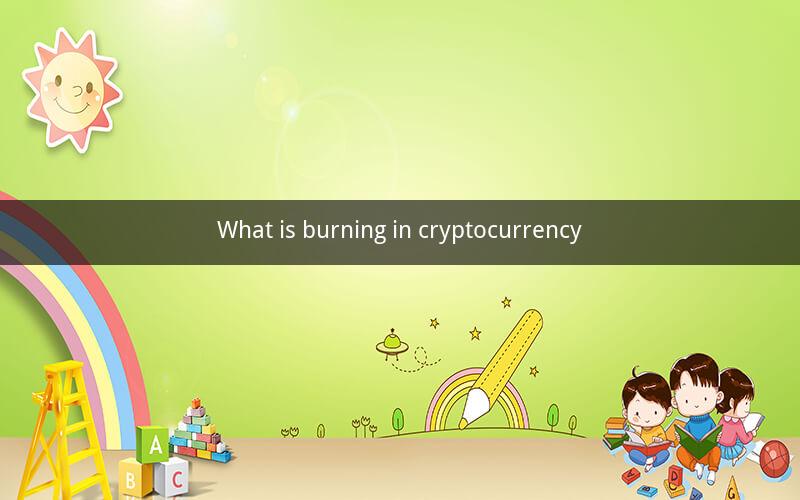
What is Burning in Cryptocurrency?
Table of Contents
1. Introduction to Cryptocurrency
2. The Concept of Burning
3. The Reasons Behind Cryptocurrency Burning
4. The Impact of Burning on Cryptocurrency Value
5. Notable Examples of Cryptocurrency Burning
6. The Future of Cryptocurrency Burning
7. Conclusion
Introduction to Cryptocurrency
Cryptocurrency, a digital or virtual form of currency, has gained significant attention over the past decade. It operates independently of a central bank and relies on a decentralized system, often powered by blockchain technology. As the crypto market continues to evolve, the concept of burning has emerged as a unique and powerful tool for manipulating supply and driving value.
The Concept of Burning
The term "burning" refers to the process of permanently removing coins from circulation. By reducing the total supply of coins, the concept aims to create scarcity and increase the value of the remaining coins. This strategy is inspired by the principles of supply and demand, where a lower supply can lead to higher prices.
The Reasons Behind Cryptocurrency Burning
1. To Combat Speculation: High levels of speculation can lead to volatile prices and market manipulation. By burning coins, projects can discourage excessive speculation and ensure a more stable market.
2. To Preserve Value: As the total supply of coins decreases, the value of the remaining coins can potentially increase. This is beneficial for both investors and users of the cryptocurrency.
3. To Promote Long-term Growth: By focusing on long-term growth, projects can incentivize users to hold their coins rather than sell them for immediate profit.
4. To Create a Sense of Exclusivity: Limited supply creates a sense of exclusivity, which can attract new users and increase the demand for the cryptocurrency.
The Impact of Burning on Cryptocurrency Value
1. Increased Scarcity: As coins are burned, the supply decreases, leading to increased scarcity and potential price increases.
2. Market Confidence: Projects that engage in burning can boost market confidence, as it demonstrates a commitment to long-term growth and sustainability.
3. Attracting Investors: By reducing supply and increasing value, burning can attract new investors to the cryptocurrency market.
Notable Examples of Cryptocurrency Burning
1. Bitcoin (BTC): While Bitcoin doesn't have a formal burning mechanism, a portion of the supply is lost due to lost private keys and other factors.
2. Binance Coin (BNB): Binance has committed to burning 50% of the total supply of BNB, aiming to reduce the total supply and increase its value.
3. Cardano (ADA): Cardano has a unique burning mechanism called the "Burn Reward" program, which allows users to burn ADA and receive rewards for their participation.
The Future of Cryptocurrency Burning
As the cryptocurrency market continues to grow, the concept of burning is likely to become more prevalent. Projects will continue to explore innovative ways to burn coins, aiming to create long-term value and stability. However, the effectiveness of burning will depend on several factors, including market conditions, regulatory changes, and the overall demand for the cryptocurrency.
Conclusion
Burning is a powerful tool in the cryptocurrency ecosystem, offering projects a unique way to manage supply, increase value, and promote long-term growth. As the market evolves, it will be interesting to see how projects continue to utilize this strategy and its impact on the crypto landscape.
Questions and Answers
1. What is the primary goal of burning in cryptocurrency?
- The primary goal of burning is to reduce the total supply of coins, creating scarcity and potentially increasing the value of the remaining coins.
2. Can burning lead to increased volatility in the market?
- While burning can help stabilize the market by reducing supply, it can also lead to volatility if not implemented carefully.
3. How does burning affect the value of a cryptocurrency?
- Burning can increase the value of a cryptocurrency by creating scarcity and reducing the total supply of coins.
4. What are some of the most notable examples of cryptocurrency burning?
- Notable examples include Bitcoin, Binance Coin, and Cardano.
5. Is burning a sustainable strategy for long-term growth?
- The sustainability of burning as a strategy depends on various factors, such as market conditions and regulatory changes.
6. Can burning be considered a form of market manipulation?
- While burning can be used to manipulate the market, it's not inherently manipulative. Its effectiveness depends on the project's commitment to long-term growth and sustainability.
7. How does burning compare to other methods of increasing a cryptocurrency's value?
- Burning differs from other methods, such as mining or staking, by permanently removing coins from circulation, creating scarcity.
8. What are the potential risks associated with burning?
- The potential risks include over-reliance on burning, which could lead to market manipulation or volatility, and regulatory challenges.
9. How can investors determine if a cryptocurrency's burning strategy is effective?
- Investors can assess the effectiveness of a burning strategy by analyzing the project's long-term growth, market stability, and the overall impact on the cryptocurrency's value.
10. What role does burning play in the broader context of the cryptocurrency market?
- Burning plays a significant role in promoting scarcity, increasing value, and encouraging long-term growth within the cryptocurrency market.